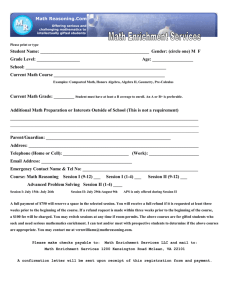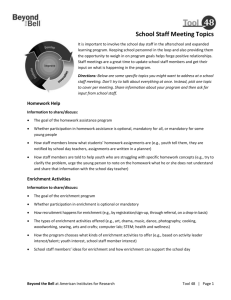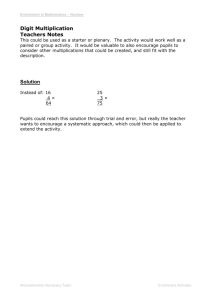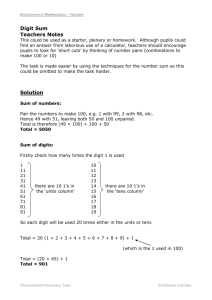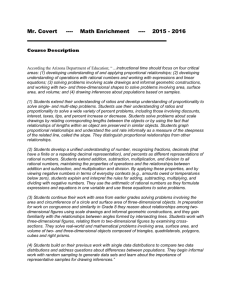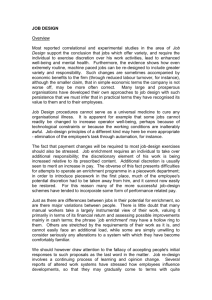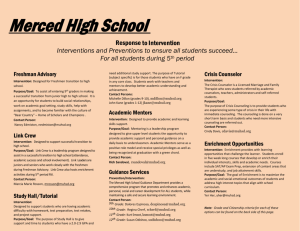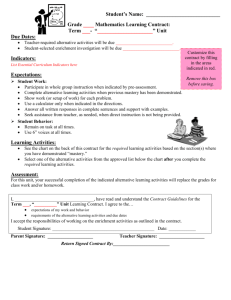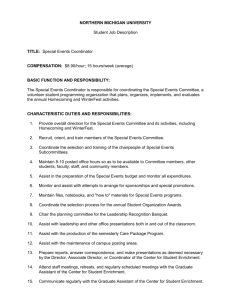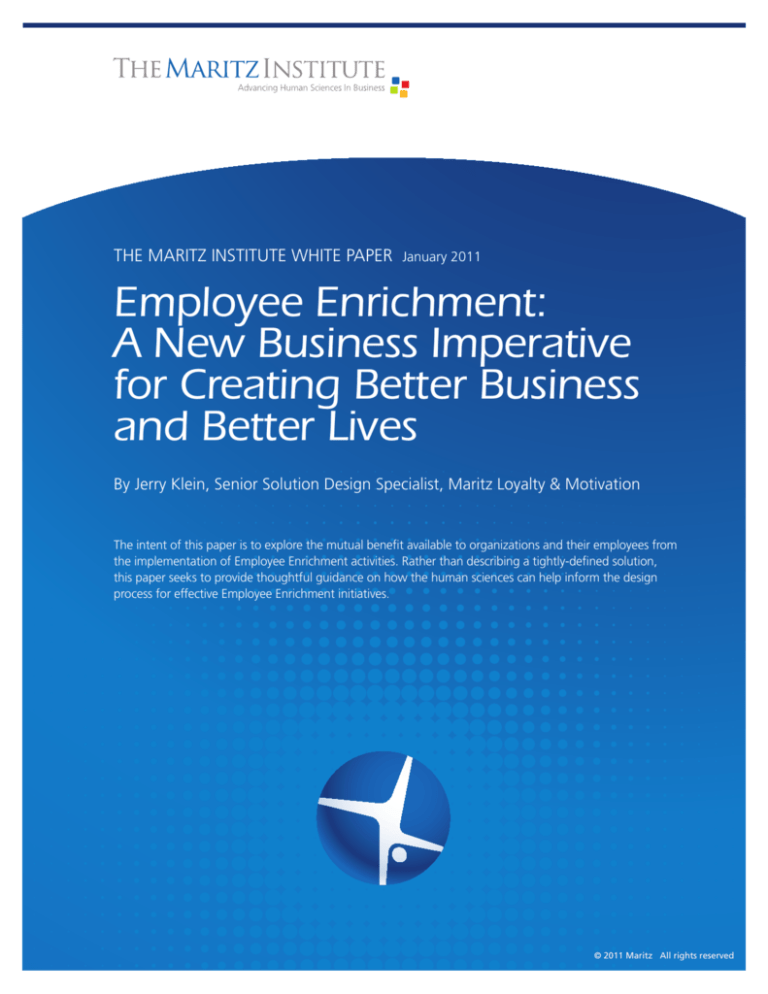
THE MARITZ INSTITUTE WHITE PAPER
January 2011
Employee Enrichment:
A New Business Imperative
for Creating Better Business
and Better Lives
By Jerry Klein, Senior Solution Design Specialist, Maritz Loyalty & Motivation
The intent of this paper is to explore the mutual benefit available to organizations and their employees from
the implementation of Employee Enrichment activities. Rather than describing a tightly-defined solution,
this paper seeks to provide thoughtful guidance on how the human sciences can help inform the design
process for effective Employee Enrichment initiatives.
© 2011 Maritz All rights reserved
THE MARITZ INSTITUTE WHITE PAPER
January 2011
Introduction
Employee engagement is a challenge that confronts every company in America. The
Corporate Executive Board reported in January 2009 that the number of disengaged
employees had doubled to 20 percent. Meanwhile, of the top performers, 25 percent were
actively looking for new jobs.1 Today’s workers are being asked to do more with less, for a
less certain prospect of future economic security and growth opportunities.
The impact on the organization is a significant drag on productivity. As they shake off the
effects of a grueling recession, companies need to re-engage and re-energize their people.
While most companies can make the connection between improved employee engagement
and financial performance, they don’t know how to effectively engage their people. In fact,
traditional top-down, command-and-control approaches to engaging employees have not
been very successful. Even the “engaged” are only marginally committed to a firm’s success;
in January 2010 the Corporate Executive Board reported that “60% of engaged employees
are not directing their efforts toward the firm’s top priorities.”2
Most companies ask the question: How can we get our employees to be more
engaged and aligned? But employee engagement has to be more than another
corporate cattle drive. Rather, companies should turn the question around and focus
on the individual: How can we provide enriching experiences and growth
opportunities for our people?
Putting the focus on the individual provides not only a path to a new level of employee
engagement, but a profound new attitude towards people. A “people-first” strategy has
an explicit focus on “better lives” as a legitimate goal of business. While a focus on people
first may be counter to traditional business thinking, creating better lives for a company’s
stakeholders, beginning with employees, may be a critical post-recession strategy for
businesses to survive and prosper. Creating better lives for employees is the primary focus of
Employee Enrichment.
Employee Enrichment is not just a means to engaging employees, but rather is a viable
and necessary end in itself. The goal of this paper is to explore some of the essential elements
of Employee Enrichment, to establish a foundation in the human sciences, and to suggest
some practices that organizations can deploy to create better lives and maximize the
potential of people.
Employee Enrichment: The Concept
Employee Enrichment requires a fundamental shift in how the organization thinks about
its people. Rather than treating the employee as a means to an end, Employee Enrichment
suggests companies should adopt “people first” practices.
A recent article from the Forum for People Performance Management and Measurement
authored by Won-joo Yun and Frank Mulhern introduced the importance of Enrichment.
The Forum defines Enrichment as “a strategic approach that genuinely emphasizes the quality
of people’s lives.”3 Enrichment is a people-first orientation within the workplace: “Central
to the concept of enrichment is a focus on the well-being of individuals. When work goes
beyond the simple execution of tasks and becomes something of greater importance to the
employee’s life, then the individual is enriched.”4
© 2011 The Maritz Institute All rights reserved
2
THE MARITZ INSTITUTE WHITE PAPER
January 2011
Enrichment activities do not only elevate the workplace experience, but can and should
extend beyond the workplace. Because Enrichment focuses on the well-being of individuals,
work itself is re-defined: “The idea of promoting personal growth among employees shifts
the focus of leadership away from strictly marketplace outcomes and moves it towards the
enrichment of people’s lives.”5 The individual is more than just an agent for creating business
outcomes, but has value and innate worth apart from their workplace functions.
Employee Enrichment is designed to foster not just the quality of the work environment
for better business performance, but richer lives for employees with personal well-being as
the goal.6 Social psychology suggests many positive outcomes from a focus on Enrichment,
including better mental and physical health. A prime example is Barbara Fredrickson’s
“broaden and build” theory of positive emotions. This theory links the cumulative experience
of momentary positive emotions to the development of resources for long-term success and
well-being. People who are happier achieve better life outcomes, including physical health
and longevity.7
What Does Enrichment Look Like?
To begin to understand enrichment, our company conducted a simple exercise. In a
small-group facilitated session, we were asked to think of a time when we felt “enriched.”
There was no requirement that the experience had to be work-related, and there were
no definitions created to circumscribe the selected experiences. After we described
our experiences, we created a list of adjectives that defined the enriching aspects
of the experience.
We were able to identify several recurring attributes among multiple experiences:
• The importance of community, of feeling connected to others, either within the
workplace or in society at large, and of collaboration with others as part of the activity
• The opportunity for self-discovery, self-improvement, skill mastery, learning,
and personal growth
• The ability to do something that made a difference and contributed to the well-being
of others, either within the organization or outside in a social or charitable setting
The “word map” below helps to capture the output of the enrichment exercise:
This Exercise established not only a better definition of enrichment, but also validated that
these core attributes are common to multiple experiences. Furthermore, these attributes
correlate to the core drives that underlie all human behavior.
© 2011 The Maritz Institute All rights reserved
3
THE MARITZ INSTITUTE WHITE PAPER
January 2011
How Human Sciences Support
the Concept of Enrichment
How does an understanding of human behavior build rationale for Employee Enrichment?
In their seminal work, Driven: How Human Nature Shapes Our Choices, authors Paul
Lawrence and Nitin Nohria identify the four primary drives that shape human behavior: the
drive to acquire; the drive to defend, the drive to bond; and the drive to learn.8 The drives
to acquire and defend are zero-sum games. In other words, they are based on a competitive
nature with others. The drives to bond and to learn, however, are non-zero sum drives. They
are based on our cooperative and creative nature. No one has to have less as these drives are
pursued. They are most tied to actualizing human potential.
While all four drives need to be satisfied, Employee Enrichment is an opportunity to satisfy the
drive to bond and the drive to learn and create. In addition, we suggest that enriching
experiences help to create positive emotional states within individuals and a
positive emotional climate at the organizational level.
The Drive to Bond: Social Connectivity
Social connectivity is a powerful motivator, both in one’s personal life and in the
workplace. Peter Drucker saw management as a social discipline and the organization
primarily as a social structure. In a recent paper, David Rock goes even further. He suggests
the workplace is an extension of our social beings: “Although a job is often regarded as a
purely economic transaction, the brain experiences the workplace first and foremost as a
social system.”9 More and more, the workplace is a central source of the friendships and
connections with others that nourish our sense of self. Nohria and Lawrence suggest that
“organizational affiliations are among the most important and valued aspects of life.”10
Mulhern and Yun suggest that relationships between people are one of the key attributes of
organizations. They use the term “human value connection” to express the innate value of
the social interactions that occur within the workplace.
The value established in our interpersonal workplace relationships goes beyond day-to-day
transactions required to get things done, but is far more profound. Workplace relationships
are a critical part of the value we create in everything we do: “human social networks at
work lead to an emphasis on the workplace community and how that culture impacts society
as a whole.”11
A key element of Enrichment is the act of building deeper connections with others and
expanding our “human value connections.” The human value connection encompasses “links
between people within an organization and links across organizations such as interactions
between employees and customers.”12 These human connections take on added importance
given today’s global, decentralized and virtual workforce. In particular, Generation Y members
of the workforce see the workplace and out-of-work interactions as intertwined. The
opportunities for collaboration and interpersonal relationships are “enriching” to all who are
part of a “value connection,” both within and outside the workplace.
The organization must be an empowering and enabling force to help people make human
value connections and pursue personal development activities. Organizations help meet the
© 2011 The Maritz Institute All rights reserved
4
THE MARITZ INSTITUTE WHITE PAPER
January 2011
need to bond by creating and nourishing a positive workplace culture: “the most effective
way to fulfill the drive to bond…is to create a culture that promotes teamwork, collaboration,
openness and friendship.”13
The Drive to Learn: Personal Development
Nohria and Lawrence define the drive to learn as the “innate drive to satisfy curiosity, to
know, to comprehend, to believe, to appreciate and to develop understandings.”14 Learning,
developing new skills and creating something of value all enhance an individual’s sense of
self-worth. The drive to learn is also known as the drive to create, which implies that as
people apply learned skills, they create new values, competencies and solutions.
The drive to learn requires two levels of autonomy. One is organizational. Managers need to
give their people the autonomy and the encouragement for personal growth. This requires
caring, authentic, people-first leadership. The second level is individual. Enrichment is not
an entitlement from a company to its people, and is not handed out like a bonus or a new
benefits package. On the contrary, it is critical that individuals “self-enroll” and embrace a
new set of challenges. Enrichment implies that individuals take ownership of their personal
development and workplace environment and create positive outcomes. Enrichment must
be driven by personal commitment. Enrichment cannot be coerced. Nor can it be a purely
calculated investment in one’s career. There must be a true level of authenticity and emotional
involvement that ennobles and elevates the individual.
Mastery of new skills, learning and self-discovery are powerful benefits of enriching
experiences. In addition, the experience of curiosity activates neural reward circuitry, which
suggests that engaging actively in a learning task feels rewarding and becomes “enriching”
in and of itself.15
The drive to learn and create leads individuals to pursue and apply new skills to create
positive outcomes in the larger social group, either the workplace or the community. The
drive to create and the drive to bond are intertwined; the act of developing oneself and
creating new value reinforces one’s bond with the community. The process of acquiring and
applying new skills positions an individual to create something greater than oneself, and to
provide social support to others. Research demonstrates that providing social support is more
beneficial than receiving it. Individuals derive benefits from helping others, such as improved
physical and mental health. Perceptions that are associated with giving, such as a sense of
purpose and belonging have been shown to increase happiness and decrease depression.16
The drives to bond and to learn suggest the following aspects need to be present to build
“better lives” through Employee Enrichment:
• Positive social connections: Enrichment requires effective collaboration and connection
to a greater community. The most meaningful growth occurs in concert with others.
Enrichment cannot happen in a vacuum. Our best thinking, our greatest inspirations,
passions and accomplishments, take their final shape as we collaborate with others.
• Personal growth and skill development: Enrichment taps into the intrinsic motivation
to grow and learn, and is not limited to workplace skill acquisition, but also includes the
opportunity to develop personal strengths, interests and passions.
© 2011 The Maritz Institute All rights reserved
5
THE MARITZ INSTITUTE WHITE PAPER
January 2011
• Contribution and service: the final attribute of Enrichment is the ability to be part of
something greater than oneself, to have a purpose that enriches others through service,
charity work, helping others develop themselves or helping a work group
or an organization succeed.
The Power Of Positive Emotions
How can Enrichment benefit not only individuals but also the workplace or society? Once
an individual is socially connected, engaged in meaningful personal development, and
able to provide value to others, then the conditions for Enrichment are in place. One way
to understand the power of Enrichment is the ability of “enriching experiences” to create
positive emotions.
The power of positive emotions and their tertiary benefits to all of work and life has been
demonstrated by Barbara Fredrickson: “feeling good” can transform people for the better,
making them more optimistic, resilient and socially connected.”17 In fact, not only do positive
emotions have the power to transform individuals, but they may also transform groups
of people. “Community transformation becomes possible because each person’s positive
emotion can resound through others. By creating chains of events that carry positive meaning
for others, positive emotions can trigger upward spirals that transform communities into
more cohesive, moral and harmonious social organizations.”18
Enrichment and positive emotions can provide resources for success in business and in
life. Frederickson suggests a series of “lived experiences such as joy can start the process
of exploring, learning, connecting and building new resources.”19 Positive emotions invite
the whole person to be engaged in the day-to-day business of work and life. Employee
Enrichment should create not just work-life balance, but work-life harmony, an integration of
multiple aspects of one’s life. Work-life harmony engages the whole person – both rational
and emotional – bringing a more fully human perspective and a more enthusiastic embrace
to all elements of work and life. Mulhern and Yun state that a proper emphasis on people
encompasses all aspects of one’s life, not just work.20
“By creating chains of
events that carry positive
meaning for others,
positive emotions can
trigger upward spirals that
transform communities
into more cohesive, moral
and harmonious social
organizations.”
Barbara Fredrickson
From Theory to Practice
How can a firm create outcomes that are enriching so that their people are energized,
passionate, creative and self-actualized? How can the firm unlock the individual’s social,
creative and collaborative powers to help create the “upward spirals” that transform
individuals and communities?
As we have previously indicated, before an individual embarks on a path of personal
growth and development, they need both the permission and encouragement from one’s
direct supervisor, who in turn needs the sponsorship of upper management and a positive
workplace culture. Employee Enrichment requires caring, personal leadership;
a culture that puts people first; and positive reinforcement of new behaviors.
Managers and leaders must make an authentic personal connection that is “people-first” and
not paternalistic or manipulative. Enrichment begins with a supervisor who makes a personal
connection, who asks people what’s important to them, and then challenges the individual
to pursue new goals. Individual leadership that is caring and nurturing yet challenging, that
nudges people out of comfort zones and familiar thought patterns, then reinforces new
behaviors, is a necessary condition for building “better lives”.
© 2011 The Maritz Institute All rights reserved
6
THE MARITZ INSTITUTE WHITE PAPER
January 2011
Positive leadership is a necessary condition for enriching experiences in the workplace.
Writing for The Maritz Institute, Mary Beth McEuen cites the critical role of leadership in
facilitating positive social interactions: “The work of developing individual leadership is to
develop self-actualizing human beings who will serve as the cornerstone for a new form of
leadership in which growth-producing social interactions are the norm.”21
Enrichment requires that organizations create a set of conditions that allow an individual to
feel socially connected, emotionally engaged and empowered to develop new skills, both
within and outside the workplace. Enrichment requires a new paradigm for leadership that is
“embedded in social interaction, not hierarchical authority.”22
Is Employee Enrichment a dream that has no practical application or chance of being
adopted? Let’s demonstrate Employee Enrichment in action through three stories where
enriching experiences contribute to a positive “people-first” culture.
“Google wants
Googlers to grow as
human beings on
all levels: emotional,
mental, physical, and
beyond the self.”
Google “Search Inside Yourself” initiatives:
Google’s School of Personal Growth is one of four in-house schools comprising Google
University. The school offers a variety of courses designed to expand employee’s horizons,
from oenology (wine) to Emotional Intelligence.
The course on mindful emotional intelligence, known as “Search Inside Yourself” (SIY)
was developed in consultation with psychologist and author Daniel Goleman. The course
emphasizes self-development and beyond-the-self training, with modules on empathy
and social skills. The goals of the course are wisdom (intrapersonal) and compassion
(interpersonal) to encourage the full development of the person. In the words of its founder,
Chade-Meng Ten, “Google wants Googlers to grow as human beings on all levels: emotional,
mental, physical, and beyond the self.” Spiritual development includes both inner peace
and happiness, and giving service and compassion to the world. Like our pre-condition for
Employee Enrichment, learned skills need to be applied to create a greater good outside of
oneself. The benefit to Google? Well-rounded employees are more likely to be creative and
thereby contribute more to the bottom line.23
Wal-Mart Personal Sustainability Project:
Wal-Mart Stores launched the Personal Sustainability Project that became part of a voluntary
commitment by individuals to personal sustainability practices with five “SMART” attributes:
• Sustains the planet
• Makes you happy
• Affects the community
• Repeatable
• Takes visible action
The goals of the movement are to measurably improve the quality of life of those who join,
to engage as many as possible in the effort, and to get one billion people to create their
own personal sustainability practices. In 4,500 retail locations, 500,000 Wal-Mart associates
formed teams and became a part of a grassroots movement. The movement has evolved
from personal sustainability to help people take control of their lives. One Wal-Mart Associate
took her PSP – learning how to recycle – and made this the touchstone of a transformational
“The goals of the
movement are to
measurably improve the
quality of life of those
who join, to engage as
many as possible in the
effort, and to get one
billion people to create
their own personal
sustainability practices.”
© 2011 The Maritz Institute All rights reserved
7
THE MARITZ INSTITUTE WHITE PAPER
January 2011
change in her life, with a goal to lose 75 pounds and get control of type 2 diabetes. While
initially focused on environmental goals, the Personal Sustainability Projects have expanded to
encompass “better lives” through self-improvement and community involvement.24
Maritz Growth Groups:
Maritz has made a commitment to support personal development with the formation of
Growth Groups. Sponsored by The Maritz Institute, Growth Groups are small leadership
communities of individuals committed to deepening and strengthening their growth as
leaders. Groups are driven completely by self-commitment. There is no external reward for
participating, nor consequence for declining the invitation. The singular benefit is personal
enrichment and growth.
Based on a foundation of mutual trust, facilitated groups of four to six individuals seek to
integrate the support of being personally connected with the challenge of mutual authenticity
and accountability. The groups also seek to integrate an internal focus on individual growth
with an external focus on development as leaders. The focus is on the transformation of the
broader leadership culture, and on making the organization more networked, collaborative,
and dynamic.
Though the concept of Employee Enrichment appears to be a revolution in how companies
treat their workforce, the above applications of people-first strategies in the workplace are
compelling models for building “better lives.” Each is anchored in a deep understanding
of people and their need for social support, personal development and “giving back.”
“The focus is on the
transformation of the
broader leadership
culture, and on making
the organization
more networked,
collaborative,
and dynamic.”
Each employs caring, people-first leadership and people-first culture rooted
in “better lives” to drive a new set of behaviors and to create conditions
for Employee Enrichment.
Positive Reinforcement
Employee Enrichment has the potential to create positive emotions and energy that can
lift up individuals and groups. To maintain the positive momentum of deepening human
value connections, creative curiosity, personal development and giving back, managers
should utilize positive reinforcement to strengthen individual development activities,
innovation, collaboration and other transformational activities. Employee Enrichment happens
in a climate of ongoing positive reinforcement that is rooted in personal, caring leadership
and a people-first culture dedicated to growth. Learning new skills, thinking differently and
changing behavior does not happen without positive reinforcement. Positive reinforcement
helps to maintain focus on activities that are integral to Enrichment.
Learning new skills,
thinking differently and
changing behavior does
not happen without
positive reinforcement.
Positive reinforcement can be achieved either through a formal reward system or through
personal, informal acknowledgement by managers of individual contributions. In either
case, Employee Enrichment becomes its own reward. The ability to attend a conference,
take a course, or learn a language may be rewarding in and of itself. Research from the Hay
Group suggests that the mix of rewards for performance is changing: differentiated rewards
programs now offer “clear career paths, global mobility and targeted development.”25
Positive reinforcement of one’s achievements by a manager is a powerful tool to reinforce
caring leadership and to nurture positive emotions.
© 2011 The Maritz Institute All rights reserved
8
THE MARITZ INSTITUTE WHITE PAPER
January 2011
Impacts and Outcomes
What evidence do we have that Employee Enrichment is not only more effective at engaging
employees than the traditional top-down approach, but that Enrichment is worth pursuing
without any specific linkage to engagement or other metrics of employee productivity?
Google has connected happy, well-rounded employees to the bottom line. Yun and Mulhern
suggest a similar correlation: “Implicit, but not dominant, is the expected positive outcome
that enriched employees have on the performance of the organization.”26 While “better
business” is a probable outcome of a people-first strategy, “better lives” through Enrichment
is a valid objective of a firm’s people strategy.
Frederickson’s theories on positive emotions contain profound implications for the impact of
Enrichment on business. As we have previously discussed, positive emotions have the power
to transform both individuals and groups. Community transformation becomes possible as
positive emotions trigger “upward spirals that transform communities.”
“Community
transformation becomes
possible as positive
emotions trigger
“upward spirals that
transform communities.”
A valuable frame of reference for understanding Employee Enrichment is Maslow’s Hierarchy
of Needs. Learning new skills and contributing something new brings one closest to Maslow’s
highest need, the need for “self-actualization.” The concept of Enrichment suggests that
companies should not be content with merely meeting the needs of workers for physical
comfort and security. Rather, investing in social acceptance, personal esteem and selfactualization is a good in and of itself. Helping employees find things they are passionate
about, then activating those passions, is a strategy for organizations to unlock the potential
of their people.
Unlocking the potential of individuals in ways that encourage them to innovate, collaborate
and develop themselves enhances their value to an organization, at the same time that
they move toward self-actualization. Maslow has said that “moving people toward selfactualization is a path to a creative and entrepreneurial workforce.”27 Self-actualization
creates opportunities to think creatively, to work collaboratively and to transform the
workplace community.
Maslow’s linkage of the self-actualized individual and the entrepreneurial workforce provides
a way for companies to think about investing in their people as a means to activate the
deeper potential of both individuals and communities. Employee Enrichment contains
“the expectation that collective personal growth of individuals actually contributes to
organizational growth and performance.”28
Our key assumption is that, treated as a means to an end, Enrichment is a
more effective way to reach the goal of engaged employees, and is a worthwhile end in itself. Towers Watson suggests that “employee engagement rises when
people experience a combination of effective and caring leadership, appealing development
opportunities, interesting work, and fulfilling tangible and intangible rewards.”29 By creating
a reciprocal path between companies and employees, it’s likely that “better lives” is a path to
“better business” that is much deeper than the traditional top-down approaches to employee
engagement.
© 2011 The Maritz Institute All rights reserved
9
THE MARITZ INSTITUTE WHITE PAPER
January 2011
It’s important that Employee Enrichment be treated not just as a means to the end of
employee engagement and higher productivity. Enrichment needs to be an authentic, peoplefirst strategy. The focus of Enrichment should be on “better lives” without any short-term
measures required to justify the investment. While future discussion of this topic will no
doubt focus on ways to measure the return on investments in people, Employee Enrichment
requires a leap of faith that “better lives” represent a legitimate focus for business.
Employee Enrichment is an exciting new horizon. The implications are new levels of
personal growth, self-realization and stronger connection to workplace and other human
communities. It’s a way to help people be self-actualized: creative, collaborative, innovative,
and entrepreneurial. The path to Enrichment begins with leaders who foster
personal responsibility and development; a people-first culture that
encourages risk-taking and collaboration; and positive reinforcement for
those who elect to begin the journey.
The Maritz Institute
Simply stated, the role of The Maritz Institute is to help create “Better Business. Better Lives.”
The Institute serves as a bridge between the human sciences and Maritz business solutions,
which are designed to help companies achieve strategic goals by engaging employees,
business partners and customers. We bring insight – anchored in science – that provides
a foundation for understanding, enabling and motivating people in ways that are most
meaningful to them. For more information, visit: www.maritz.com/institute.
© 2011 The Maritz Institute All rights reserved
10
THE MARITZ INSTITUTE WHITE PAPER
January 2011
References
1. Corporate Leadership Council, 2009 Survey,
“Employee Performance in the Economic Downturn”
2. Corporate Executive Board, 2010
3. “Leadership and the Performance of People in Organizations:
Enriching Employees and Connecting People,” Won-joo Yun and
Frank Mulhern, Forum for People Performance Management and
Measurement, November 2009, pg. 15
4. “A New Age: Putting People First ,” Won-joo Yun and
Frank Mulhern, Forum for People Performance Management
and Measurement, 2010, pg. 3
5. “Leadership and the Performance of People in Organizations:
Enriching Employees and Connecting People,” Won-joo Yun and
Frank Mulhern, Forum for People Performance Management and
Measurement, November 2009, pg. 23
6. “Leadership and the Performance of People in Organizations:
Enriching Employees and Connecting People,” Won-joo Yun and
Frank Mulhern, Forum for People Performance Management and
Measurement, November 2009, pg. 15
7. “Happiness Unpacked: Positive Emotions Increase Life Satisfaction by
Building Resilience,” Fredrickson, Cohn, Brown, Conway & Mikels,
2009 American Psychological Association, pg 361
8. Driven: How Human Nature Shapes our Choices, Paul Lawrence
and Nitin Nohria, pg. 5
9. “Managing with the Brain in Mind,” David Rock,
Strategy + Business, Issue #56, Autumn 2009
10. Driven: How Human Nature Shapes our Choices, Paul Lawrence
and Nitin Nohria, pg. 100
11. “A New Age: Putting People First ,” Won-joo Yun and
Frank Mulhern, Forum for People Performance Management
and Measurement, 2010, pg. 4
12. “Leadership and the Performance of People in Organizations:
Enriching Employees and Connecting People,” Won-joo Yun and
Frank Mulhern, Forum for People Performance Management and
Measurement, November 2009, pg. 12
13. “Employee Motivation: A Powerful New Model”: Nitin Nohria,
Boris Groysberg and Linda Eling Lee, Harvard Business Review,
July-August 2008
14. Driven: How Human Nature Shapes our Choices, Paul Lawrence and
Nitin Nohria, pg. 107
16. “Providing Social Support May be More Beneficial than
Receiving It: Results from a Prospective Study of Mortality,”
Brown, Neese, Vinokur, and Smith,
American Psychological Society, Vol. 14 No. 4 July 2003
17. Barbara Fredrickson, “The Value of Positive Emotions,”
The American Scientist, 2003, pg. 334
18. Barbara Fredrickson, “The Value of Positive Emotions,”
The American Scientist, 2003, pg. 330
18. Barbara Fredrickson, “The Value of Positive Emotions,”
19. Barbara Fredrickson, “Happiness Unpacked: Positive Emotions
Increase Life Satisfaction by Building Resilience,”
American Psychological Association 2009 pg. 367
20. “Leadership and the Performance of People in Organizations:
Enriching Employees and Connecting People,” Won-joo Yun and
Frank Mulhern, Forum for People Performance Management and
Measurement, November 2009, Pg. 27
21. “The Changing Game of Business and Leadership,”
The Maritz Institute
22. “The Changing Game of Business and Leadership,”
The Maritz Institute
23. “Buddha in the Googleplex,” Joan Duncan Oliver,
Tricycle, April 2010
24. “The Birth of BLUE,” A Speech to the Commonwealth Club
by Adam Werbach
25. The Hay Group, “The Changing Face of Reward,” 2010 pg 4
26. “Leadership and the Performance of People in Organizations:
Enriching Employees and Connecting People,” Won-joo Yun and
Frank Mulhern, Forum for People Performance Management and
Measurement, November 2009, pg. 16
27. A.H. Maslow, Maslow on Management, New York:
John Wiley & Sons Inc., 1998
28. “Leadership and the Performance of People in Organizations:
Enriching Employees and Connecting People,” Won-joo Yun and
Frank Mulhern, Forum for People Performance Management and
Measurement, November 2009 pg. 23
29. “Turbocharging Employee Engagement,” The Power
of Recognition from Managers: Part 1- The Engagement Engine,
Towers Watson, April 2009
15. “The Wick in the Candle of Learning : Epistemic Curiosity Activates
Reward Circuitry and Enhances Memory,” CamererMin Jeong
Kang, Ming Hsu, Ian M. Krajbich, George Loewenstein, Samuel M.
McClure, Joseph Tao-yi Wang and Colin F.Camerer, Psychological
Science 2009 20:963
© 2011 Maritz All rights reserved
11


